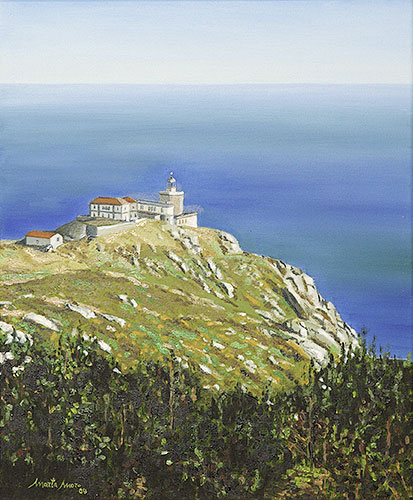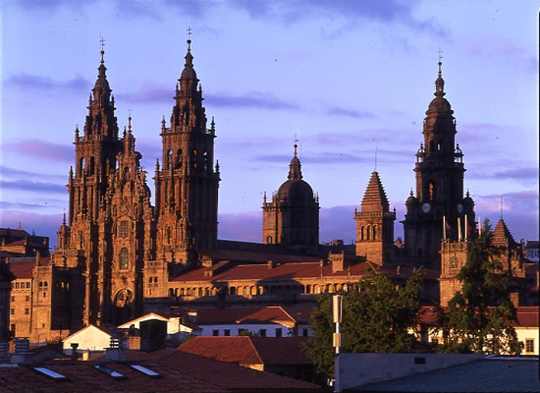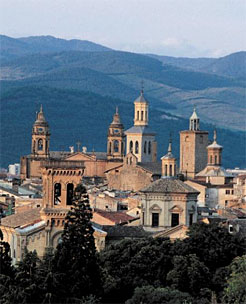
As a cradle Lutheran, I didn't grow up with a robust spectrum of saints. Although Luther included the "Hail Mary" in his prayer book, he generally frowned on intercessors, advising his flock to intercede for and with each other. Good advice, but it leaves personal prayer a lot of distance to cover on its own -- and it leaves Lutheranism with a very weak grasp of the feminine.
Katy Luther reputedly made great beer, but apparently not good enough for Luther to beatify her. Very quietly, though, some of us already have. At the very least, she gets points for putting up with Luther's rants.
Perhaps that's why I've been moved by the presence of the Virgin along the Camino, particularly the Camino Frances, or the French route. Mary is everywhere: Nuestra Senora de la Vega, Santa Maria de las Estrellas, Santa Maria del Perdon, respectively, Our Lady of the Meadow, Mary of the Stars, Mary of Forgiveness. Indeed, our journey started in Pamplona at a hotel located on the mysterious plaza dedicated to the Virgen de la O. We entertained ourselves for hours imagining what that "O" might stand for.
At a Franciscan church in Santiago, we discovered the delightful Nuestra Senora de Valvanera, Our Lady of the Valley of Venus. My particular favorite is the Madonna de la Leche, the Virgin nursing an infant Jesus. Jesus either looks divinely disinterested or he hungrily reaches for the breast.
The images of Mary are as abundant as her names. The Mater Dolorosa, Our Lady of Sorrows, always wears a black triangular garb, and she often appears with seven swords piercing her heart. We often found her at the altar of a side chapel, the crucified and entombed Jesus lying below her. This was a kind of Pieta, all the more anguished because Mary reaches out for a dead child separated from her by the marble slab of an altar.
More often, though, we saw Mary as the Madonna, with Jesus on her lap. One of them was holding an apple, for historically Mary inaugurates a new creation. She represents the New Eve, just as Christ stands in as the New Adam: Nuestra Senora of Second Chances.
As she participates in the ordinary joys and sorrows of human life, Mary becomes a very plastic image. Perhaps she's everywhere, because she is closer to us than the rest of the Godhead. She's on our side.
Mary really is the Lady of the Camino. The route may be called the Camino of St. James, but Mary presides over the French route.
St. James plays a strange role. He's there -- and in equally fluid form, but the figure of James is more ambiguous. Sometimes he appears as the Pilgrim Saint, having been deputized by Christ to go to Galicia and turn all the Druids there into Christians. He had very modest luck and returned to Jerusalem, where he was promptly beheaded around 44 CE. Legend tells us that his disciples returned with his body to Galicia.
There James gets reincarnated as the Knight, and we found many images of Santiago Matamoros, James the Slayer of the Muslims. Historically, he could never have done this; Muhammed's death is a good six centuries after James'. But the Moors inhabited much of Spain in the early Middle Ages. Once Christian armies found victory marching into battle bearing the relics of James, religious iconography caught up. Who cares about history?! We found lots of images of James alive, well, and on horseback, beheading Muslims. At least, he knew something about beheading....
In the fifteenth century, the conquistadors brought James the Knight with them to the Americas as part of the Conquest. He took on another job description: slayer of the Aztecs, the Incas, the Mayans, and anyone else who got in the way of the Spanish Empire. There are images of James alive and on horseback, this time killing the native peoples.
Those who weren't killed were Catholicized, but the saints of New Spain's Catholicism only thinly covered the already existing gods and goddesses of the Aztec, Mayan, and Incan religions. Native peoples adopted Catholic saints -- and then adapted them. In the Guadalupe, Mary takes on the traits of Tonantzin, Aztec goddess of the heavens. James the Knight takes on traits of Illapa, the Incan god of lightning, thunder, and rainstorms.
With nationalist movements of the eighteenth and nineteenth centuries, we find images of James the Slayer of the Spaniards, Santiago Mataespanois. The conquering saint takes the side of the conquered.
We studied the rich spectrum of saints affiliated with pilgrimage at the fine Museum of Pilgrimage in Santiago. Their images are powerfully labile, telling more about the people who revered them than the saints themselves.
But then, saints always do: they embody the deepest needs of the human heart, both its darkness and its beauty.
I am struck with these two saints and their images, one of carnage and conquest, the other of nurture and compassion. Despite the peace Jesus preached, lived, and simply was -- those hard teachings about loving the enemy -- we still want James to fight for us. But we will always need Mary to feed us and to share our tears.
I'll take Mary, Nuestra Senora del Camino -- the mysterious Virgen de la O.









